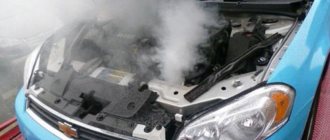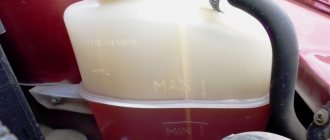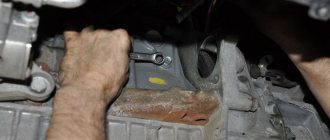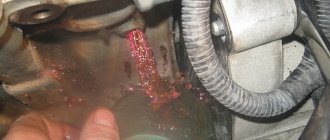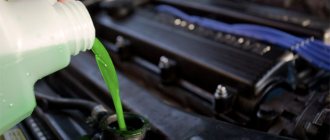Why does antifreeze boil? This situation can arise for a variety of reasons, for example, the cap of the expansion tank of the cooling system has depressurized, the thermostat has malfunctioned, the coolant level has decreased, bad antifreeze has been filled in, the cooling fan or temperature sensor has failed. The main thing that the driver of a car with antifreeze boiling should remember is: further movement is impossible! Failure to comply with this rule can lead to complete engine failure, which can lead to costly and complex repairs. However, eliminating the causes of antifreeze boiling is actually not that difficult, and sometimes even a novice car owner can do it.
Causes of boiling and their solutions
To begin with, we will analyze in detail all the reasons why antifreeze boils.
- Faulty thermostat .
The main task of this device is not to supply coolant to the radiator until the engine reaches a certain operating temperature (usually +85°C), that is, to transfer it to the so-called “large circle”. However, if the unit does not turn on in time and does not circulate the coolant through the system, it will quickly heat up in the “small circle” along with the engine and simply boil because it will not have time to cool. Dirty thermostat - Faulty radiator . The function of this unit is to cool the antifreeze and maintain the cooling system in working order. However, it may suffer mechanical damage or simply become clogged from the inside or outside.
- (centrifugal pump) failure Since the task of this mechanism is to pump coolant, if it fails, its circulation stops, and the volume of liquid that is in close proximity to the engine begins to heat up very much and, as a result, boils.
- Low antifreeze level . A cooling system that is not filled to the required level does not cope with its task, so the temperature exceeds the critical temperature and the liquid boils.
- Cooling fan failure . Its function is to force cool the elements of the system of the same name and the liquid. It is clear that if the fan does not turn on, the temperature will not drop and this may result in the antifreeze liquid boiling. This situation is especially critical for the warm season.
- Presence of an air lock . The main reason for its appearance is depressurization of the cooling system. As a result, several factors harmful to it arise at once. In particular, the pressure drops, which means the boiling point of antifreeze decreases. Further, when air remains in the system for a long time, the inhibitors included in the antifreeze deteriorate and do not perform their protective function. And finally, the coolant level drops. This has already been mentioned earlier.
- Temperature sensor failure .
Everything is simple here. This unit has not sent the appropriate commands to the thermostat and/or fan. They did not turn on and the cooling system and radiator boiled. Pump corroded by antifreeze - Poor quality antifreeze . If the car is filled with low-quality antifreeze, that is, a liquid that does not meet the necessary requirements, which means there is a high probability that the radiator will boil. In particular, we are talking about the fact that counterfeit coolant often boils at temperatures below +100°C.
- Antifreeze foaming . This can happen for various reasons. For example, low quality coolant, mixing incompatible antifreeze, using antifreeze that is not suitable for the car, damage to the cylinder block gasket, which causes air to enter the cooling system, and as a result, its chemical reaction with the coolant to form foam.
- Depressurization of the tank lid . The problem may be either a failure of the safety bleed valve or a depressurization of the cover gasket. Moreover, this applies to both the expansion tank cap and the radiator cap. Because of this, the pressure in the cooling system is compared to atmospheric pressure, and therefore the boiling point of the antifreeze decreases.
To restore the functionality of the cooling system, and in future to prevent situations where antifreeze or antifreeze boils quickly, it is necessary to inspect the components listed above. Let us list the sequence in which it is necessary to check the specified components in accordance with the probability and frequency with which they fail.
Antifreeze foaming
- Expansion tank and its cap . This is especially true if the antifreeze in the expansion tank has boiled and steam is coming from underneath it. It is better to replace the entire cap and valve.
- Thermostat . This unit needs to be checked if the radiator is cold and the antifreeze is boiling when the engine is turned on. It also makes sense to check the thermostat after replacing the coolant if it immediately boils.
- Cooling Fan . It rarely fails, but it makes sense to check. As a rule, problems arise in dropped contacts or breakdown of the insulation of the stator and/or rotor windings.
- Temperature sensor . The device is quite reliable, but sometimes fails on older machines. Actually, it controls the operation of the fan on the radiator
- Centrifugal pump (pump) . This is similar to the previous point..
- Cooling radiator . It is necessary to carefully inspect it for damage and possible coolant leaks. If it leaks (this will be accompanied by a situation where antifreeze is leaking), then it is necessary to dismantle it and solder it. As a last resort, replace it with a new one. You can simply clean it if it is very clogged. For external cleaning it is better to remove it. And internal cleaning occurs along with the entire cooling system (without dismantling).
- Check the antifreeze level in the system . It can leak from a damaged system, and the remaining volume cannot withstand the heat load and boils. If a low-quality liquid with a low boiling point is used, it must be replaced completely. Otherwise, you can simply add antifreeze.
- Check whether the added antifreeze is suitable for the current car . If there was a mixing of two brands of coolant, make sure that they are compatible with each other.
- Check the operation of the safety release valve . You can check the operation of the valve on the lid using polyethylene.
- Check the quality of the filled antifreeze . This can be done in several ways, using both professional equipment and improvised means available in the garage or at home.
Bad antifreeze is death to the engine
The boiling and freezing points of coolant depend on the composition. The consequence of pouring bad (fake) antifreeze is boiling and destruction of the engine. Find out the signs and testing methods to determine that it is bad Read more
As a rule, you only need to complete one of the listed points. However, in difficult situations, failure of several of the listed units is possible.
Remember that all repair and maintenance work on the cooling system must be performed only when the engine is cool. Under no circumstances should you open the expansion tank cap when the engine is hot! This way you risk getting a severe burn!
Often, boiling occurs when the car is moving in a lower gear while the engine is running at high speeds, for example, during long driving in the mountains or in city traffic jams in the summer heat. The situation is aggravated if the air conditioning is turned on, since it puts additional load on the cooling system, in particular the main radiator. Therefore, before traveling to the mountains, be sure to check the condition of the engine cooling system, including the level of antifreeze in it. If necessary, top it up or replace it.
It is not recommended to use antifreeze that contains more than 60% ethylene glycol by volume and less than 40% water by volume.
Often the cause of antifreeze boiling can be the formation of an air lock in the cooling system. Symptoms of its formation are problems with the thermostat, antifreeze leakage, problems with the pump and the interior heater. Therefore, if at least one of the listed problems exists on your car, then it is recommended to correct the situation, since ignoring it can cause the engine to boil.
Some drivers are interested in the question of why antifreeze boils after stopping? There are several options here. The first is when the car is stationary with the engine running. This means that this is just a coincidence, and you are lucky that you discovered a situation when antifreeze boiled not while driving, but on the road or in the garage. In this case, immediately turn off the engine and set the car to the handbrake. We'll talk about further actions a little later.
Low antifreeze level
Another possibility is that smoke (steam) continues to come from under the hood after you have detected a boil and pulled over to the side of the road. It is necessary to understand that most liquids, and antifreeze is no exception, have a high thermal specificity. This means that it takes a long time to heat up and cool down. Therefore, the situation is when you observe boiling coolant, which will stop evaporating some time after stopping the engine.
There are exotic options when it bubbles in the expansion tank after the engine is turned off. For example, the situation described below is relevant for the Chrysler Stratus. It consists in the fact that after stopping the engine, the radiator safety valve releases pressure into the expansion tank. And the effect is that everything is boiling there. Many car enthusiasts mistake this process as a blown cylinder head gasket and rush to change it. However, there is no need to rush, but instead it makes sense to carefully study the cooling system diagram of a particular car.
Radiator fan
As you understand, the engine operates in a variety of modes. Sometimes he pulls the car along the highway at high speed, and sometimes through a traffic jam. And in the latter case, the speed is lower than that of pedestrians.
What's the difference? And the fact is that the radiator on a VAZ 2107 car is blown in these two modes with different amounts of air. In the first case, the flow is enough to maintain the temperature balance, but in the second it is not enough. And it doesn’t matter whether it’s an injector or a carburetor, the radiator must be blown normally.
You have to create an artificial flow using an electric fan. In earlier VAZ 2107 cars (and indeed in the “classic” series) impellers were used that were mounted on the axis of the liquid pump. With the help of these mechanisms, the radiator is subjected to airflow. An electric fan may not perform its functions for the following reasons:
- The impeller has been destroyed.
- The sensor responsible for turning on the fan has failed.
- The motor winding burned out.
- Destruction of electrical wiring (breakage, contact failure, oxidation).
- Failure of a relay, fuse, button (if these elements are present in the design).
The last point applies mostly to VAZ 2107 cars, in which the fan switching circuit has been modified by installing a button in the passenger compartment. With its help, the driver can forcefully start the fan.
If it doesn’t start even from the button, you need to find out the reasons. To do this, connect the wires from the fan to the battery terminals. If it doesn’t work, the motor winding is damaged.
Please note: for better airflow, use a diffuser! This is a small plastic element that will force more air to flow to the radiator. And if there are no breakdowns in the fan, then be sure to install a diffuser, the radiator will thank you.
What are the consequences when antifreeze boils?
The consequences of antifreeze boiling depend on how overheated the engine is. And this, in turn, depends on the brand of the car (engine power and body weight), the design of the motor, as well as the time between when the engine began to boil and when it stopped (the moment when it turned off and began to cool). Let us conditionally divide the possible consequences into three degrees - mild, moderate and severe.
So, with slight overheating of the engine (up to 10 minutes), slight melting of the engine pistons is possible. At the same time, they can slightly change their geometry. In most cases, this situation is not critical, unless there were problems with the geometry before. If you notice the boiling of antifreeze in time and take appropriate measures, which will be discussed later, then it is enough to eliminate the cause of the breakdown and everything will be fine.
Engine overheating
To find out the reason for engine overheating, you need to check whether the radiator is clogged, also... Read more
The average case of overheating occurs approximately 20 minutes after antifreeze or antifreeze boils. So, the following types of breakdowns are possible:
- curvature of the cylinder head housing (relevant when the engine temperature reaches +120 degrees and above);
- cracks may appear on the cylinder head (both microcracks and cracks visible to the human eye);
- melting or burning of the cylinder block gasket;
- failure (usually complete destruction) of the inter-ring partitions located on the motor pistons;
- The seals will begin to leak engine oil, and it can either flow out or mix with the boiling antifreeze.
The breakdowns already listed are enough to imagine the scale of the tragedy that can happen to a car if the antifreeze boils. All this is fraught with a major overhaul of the engine .
Expansion tank with cap
However, if the driver for some reason ignores the boiling and continues to drive further, then the so-called critical “wave of destruction” occurs. In very rare cases, the motor may simply explode, that is, completely burst and fail, but this does not happen often. As a rule, destruction occurs in the following sequence:
- Melting and combustion of engine pistons.
- During the above-mentioned melting process, molten metal falls on the cylinder walls, thereby impeding the movement of the pistons. Eventually the piston also breaks down.
- Often, after the pistons fail, the car simply stalls and stops. However, if this does not happen, then problems with the engine oil begin.
- Due to the fact that the oil also reaches a critical temperature, it loses its performance properties, which puts all rubbing parts of the engine under attack.
- Typically, small parts melt and stick to the crankshaft in liquid form, naturally making it difficult to rotate.
- After this, the valve seats begin to fly out. This leads to the fact that, under the influence of at least one piston, the crankshaft simply breaks, or, in extreme cases, bends.
- A broken shaft can easily pierce one of the walls of the cylinder block, and this is tantamount to complete engine failure, and what is most interesting is that such an engine is unlikely to be restored.
Obviously, the consequences of boiling antifreeze in the cooling system can be very sad for both the car and its owner. Accordingly, it is necessary to maintain the cooling system in order, regularly monitor the antifreeze level, and, if necessary, top it up to the normal level. And if boiling does occur, you need to react as quickly as possible and take action to correct the problem.
Is the problem in the expansion tank?
There may also be a malfunction in it. Please note a few points:
- Are there any cracks in the tank?
- Does the cork allow air to pass freely?
- Are the clamps tightened securely?
- Is the fluid level within acceptable limits?
Only by answering all these questions will it be possible to talk about whether there are any defects in the expansion tank. If there are cracks in it, then antifreeze will leak through them. These are the reasons for the rise in temperature. Injector or carburetor - it doesn’t matter, the expansion tank must be in perfect condition.
The consequence is that you constantly need to top it up, as the level in the expansion tank will begin to drop. A drop in level is the first step towards overheating. Try to keep it between O and MIN.
In this case, only the antifreeze will circulate normally through the system. The reasons for boiling often lie in the little things. For example, the engine boiled after the driver failed to monitor the antifreeze level.
What to do if antifreeze boils
What to do if the engine boils
However, the most interesting and interesting question for drivers is the following - what to do if antifreeze/antifreeze boils on the road or in a parking lot. The first thing to remember is not to panic, that is, to keep the situation under control! It is advisable to draw attention to the fact that the cooling system has partially failed as soon as possible. This can be done either using instruments on the panel or visually by looking at the steam coming out from under the hood. The sooner you take appropriate action, the greater the likelihood of getting away with inexpensive repairs.
There is a simple algorithm that every car enthusiast should know, even those who have never encountered a similar situation. It consists of the following steps:
- Switch to neutral speed and reduce engine speed to idle.
- Continue driving and do not suddenly slow down. The oncoming air will blow the engine as much as possible to cool it.
- While still driving turn on the interior heater to the highest possible temperature. Moreover, this must be done regardless of the time of year, that is, if necessary, even in the summer heat. This procedure is done in order to remove heat from the radiator as much as possible so that it cools down as much as possible at no-load speed.
- You need to roll for as long as possible, until it comes to a complete stop (if this happens in the summer, then it is advisable to find a stopping place somewhere in the shade , without direct sunlight). Afterwards the engine must be turned off. In this case, the ignition must be left on in order to allow the stove to work for another 5…10 minutes . After this, turn off the ignition.
- Open the hood in order to give maximum access to natural air into the engine compartment. Without touching any engine parts with your hands (now they are at an extremely high temperature), wait a certain time . In summer it is about 40...50 minutes, in winter - about 20. Depends on weather conditions and the time the car was “boiling”.
- Call a tow truck or a car that will tow the car to a service station or to a good mechanic with the appropriate diagnostic equipment.
Dirty radiator - If there are no cars nearby, then after the mentioned time, making sure that there is no more boiling and the liquid has “calmed down,” carefully unscrew the cap of the expansion tank of the cooling system and add clean water . If you are traveling close, you can use some non-carbonated drinks. Fill to the mark.
- Start the car, turn on the heater to maximum and continue driving at low speeds. As soon as the coolant temperature reaches +90°C, you need to stop and wait again for about 40 minutes . If you're not far away, you're in luck. Otherwise, you need to look for an option with a tow truck or tug.
- Upon arrival at the service station, tell the technicians about the problem; usually they can easily find the breakdown (among those described above) and fix it.
- Also be sure to ask them to change the antifreeze , since the liquid that is currently in the system has already lost its performance properties.
- Carry out a breakdown diagnosis in order to find the cause of the boiling and eliminate it so that the situation does not recur in the future.
The algorithm of actions is simple, and even an inexperienced driver can cope with it. The main thing is to notice the process of antifreeze boiling in time. And it is advisable to always have a small supply of coolant (similar or compatible with that currently used) in the trunk, as well as engine oil. The canister does not take up much space, and can come in handy at a critical moment.
Pump drive problem!
The circulation of coolant in the system directly depends on the water pump. The higher its performance, the better the cooling process. To improve performance, they use “tuned” pumps with a larger number of blades on the impeller.
This is reasonable and correct, especially in cases where the engine has been modified and improved. And if the tuned engine does not boil when working with the original cooling system, then this is something out of the ordinary.
If you open the hood of a VAZ 2107, you will definitely see one feature - the liquid pump and generator are driven by one belt. Hence the conclusion - if it breaks or weakens, then the antifreeze moves through all channels at a lower speed, cooling worsens significantly.
The way out of this situation is to replace the belt or tighten it. On a VAZ 2107 car, like on most others, this is done in literally two movements. And with this we are just beginning to consider the reasons why the engine began to boil. Further more interesting.
What not to do when the engine is boiling
There are a number of strict rules that limit the driver’s actions during a situation when antifreeze boils in the radiator, expansion tank or other element of the cooling system. These rules are designed to protect human health from causing serious injury, and to minimize material losses that may arise in the described situation.
- Do not load the engine (do not accelerate, but instead you need to reduce the speed to idle as much as possible, usually around 1000 rpm).
- Do not stop abruptly and turn off the engine, thinking that the engine will stop boiling; on the contrary, everything will only get worse.
- Do not touch hot parts in the engine compartment!
- While steam is coming from under the cap of the expansion tank or other unit and while the antifreeze is bubbling in the system, you should absolutely not open the cap of the expansion tank! This can only be done after the time specified above has passed.
- Do not pour cold water on the engine! You need to wait for the engine to cool down on its own.
- After the engine has cooled down and new antifreeze has been added, you should not drive after the temperature reaches more than +90 degrees.
Compliance with these simple rules will ensure the safety of the driver, and also minimize the degree of breakdown and, consequently, possible material costs.
Air conditioner
I would also like to mention when the engine gets hot when the air conditioning is turned on. The situation with the air conditioner is ambiguous. The increase in load on the engine has already been taken into account by the factory, but if it is in poor condition and the cooling system is faulty, this is still possible.
Dirty air conditioner radiator
The second reason related to air conditioning is dirty radiators. The air conditioning radiator is installed in front of the cooling radiator and in hot weather, if heat is not removed from it well, it heats up itself, and a “dirty” main one leads to overheating of the engine.
The design of the VAZ 2107 cooling system
The main components of the VAZ 2107 cooling system include:
- water pump (pump);
- main radiator;
- main radiator fan;
- interior heater (stove) radiator;
- stove tap;
- thermostat (thermostat);
- expansion tank;
- coolant temperature sensor;
- coolant temperature sensor indicator;
- control temperature sensor (only in injection engines);
- fan switch sensor (only in carburetor engines);
- connecting pipes.
This should also include the engine cooling jacket - a system of special channels in the cylinder block and cylinder head through which coolant circulates.
Water pump (pump)
The pump is designed to ensure continuous forced circulation of coolant through the engine cooling jacket during operation. It is a conventional centrifugal pump that pumps antifreeze into the cooling system using an impeller. The pump is located on the front of the cylinder block and is driven by the crankshaft pulley through a V-belt.
About the operation of the cooling system
Without understanding the operating principle of the cooling system, it is difficult to diagnose the causes of problems and make repairs. The scheme operates according to the following algorithm:
- Until the engine is warmed up, antifreeze (antifreeze) circulates through a small cooling circle, which includes the engine water jacket, heater and thermostat. The fluid level (abbreviated as coolant) in the expansion tank remains within normal limits.
- As the engine heats up, the thermostat opens a large circulation circuit through the main radiator. The antifreeze in the system expands and its excess enters the tank. The increasing pressure is released by the bypass valve of the cover.
- When 95°C is reached, all liquid passes through the main radiator and expands to its maximum volume. The excess is discharged through the additional upper radiator pipe, so it seems that the antifreeze is boiling in the container.
- Cooling of the power unit leads to compression of the coolant to its original volume and a drop in pressure. To prevent vacuum from occurring, the bypass valve of the expansion tank plug allows outside air into the system.
Depending on the design of the cooling system, the cap with the valve is installed on the expansion tank or the radiator neck. In the second case, liquid discharge begins after a certain pressure is exceeded, and the tank is constantly connected to the atmosphere through a hole in the plug.
Dirty cooling system
The liquid can also boil if the heat exchanger is dirty. The radiator can become clogged with dirt from the outside, or maybe from the inside. The latter happens most often when using low-quality antifreeze or even plain water.
It is strictly not recommended to use water in the cooling system. Firstly, its boiling point is lower than that of antifreeze. Secondly, it starts corrosion processes inside the system. And thirdly, it does not have the lubricating effect necessary for the same pump.
In addition, by pouring plain water, the car owner runs the risk that all kinds of lime deposits can tightly clog all the channels in the engine through which fluid should circulate
And, if a carburetor is installed on the engine, then this is not so critical, but for the injector this is important, since it also has such channels
To summarize, we can conclude that the cooling system in the internal combustion engine plays a very important role and its malfunctions can lead to much more serious damage.
Coolant
The manufacturer recommends using exclusively antifreeze as a coolant for the VAZ 2107. For the uninitiated car enthusiast, antifreeze and antifreeze are one and the same thing. Antifreeze is usually called all coolants without exception, regardless of where and when they were produced. Antifreeze is a type of antifreeze produced in the USSR. The name is an abbreviation for “separate laboratory organic synthesis technology.” Without exception, all coolants contain ethylene glycol and water. The differences are only in the type and quantity of anti-corrosion, anti-cavitation and anti-foam additives added. Therefore, for the VAZ 2107 the name of the coolant is not of great importance.
The danger comes from cheap, low-quality coolants or outright counterfeits, which have recently become widespread and are often found on sale. The result of using such liquids can be not only a radiator leak, but also failure of the entire engine. Therefore, to cool the engine, you should buy coolant from proven and well-established manufacturers.
General characteristics of the VAZ 2107 cooling system
The VAZ 2107 engine of all models has a sealed liquid cooling system with forced circulation of coolant (coolant).
Purpose of the cooling system
The cooling system is designed to maintain the optimal temperature of the power unit during its operation and timely, controlled removal of excess heat from heating components. Individual elements of the system are used to heat the interior during the cold season.
Cooling system parameters
The cooling system of the VAZ 2107 has a number of parameters that affect the operation and performance of the power unit, the main of which are:
- amount of coolant - regardless of the fuel supply method (carburetor or injection) and engine size, all VAZ 2107 use the same cooling system. According to the manufacturer's requirements, its operation (including interior heating) requires 9.85 liters of refrigerant. Therefore, when replacing antifreeze, you should immediately purchase a ten-liter container;
- engine operating temperature - The operating temperature of the engine depends on its type and volume, the type of fuel used, the number of crankshaft revolutions, etc. For the VAZ 2107 it is usually 80–95 0 C. The engine is heated to operating condition depending on the ambient temperature for 4–7 minutes. If there is a deviation from these values, it is recommended to immediately diagnose the cooling system;
- coolant operating pressure - Since the cooling system of the VAZ 2107 is sealed, and antifreeze expands when heated, a pressure exceeding atmospheric pressure is created inside the system. This is necessary to increase the boiling point of the coolant. So, if under normal conditions water boils at 100 0 C, then when the pressure increases to 2 atm, the boiling point rises to 120 0 C. In the VAZ 2107 engine, the working pressure is 1.2–1.5 atm. Thus, if the boiling point of modern coolants at atmospheric pressure is 120–130 0 C, then under operating conditions it will increase to 140–145 0 C.
It's a traffic jam!
The cooling systems used in the eighth VAZ family and higher use a slightly different design. The formation of traffic jams is almost impossible (but possible). But in a VAZ 2107, an air plug can appear at any time. And there can be a lot of reasons for this, but most often it is a violation of the tightness of the system.
Carefully inspect all pipes for cracks and damage. Using a socket on “6” or “8”, check the tightness of all clamps. After this, inspect the radiators (including the one used in the heater) to see if there is damage to the cells. If the antifreeze is thrown out of the tank, then you have the most unpleasant breakdown; we will talk about it a little later.
The thermostat is the boss
Not a very pleasant breakdown, especially if it happens on the road. And if the engine is boiling due to a faulty thermostat, then there is only one way out - to change this element of the system. True, at first you can slightly “reanimate” him; for this you need to apply several sharp blows to his body with something heavy.
But such a “rough” solution may not always help. There will be much more trouble if liquid leaks out of the tank. The thermostat allows the system to switch the circulation of liquid between two circles - large and small. These circles differ in that in the first one a radiator is connected to the cooling process. And if it does not connect, then the liquid boils.
On VAZ 2107 cars, and indeed on all cars of this manufacturer, the thermostat fails in such a way that the antifreeze continues to circulate in a small circle. And even if you turn on the radiator fan with the button, this will not save the situation.
The car still drives poorly, the antifreeze boils, and you won’t be able to immediately understand why this is happening. And the answer is very simple - to increase the life of the thermostat, do not pour running water into the system. Use any antifreeze, in particular antifreeze. The water leaves a large amount of scale, which interferes with the movement of the thermostat element.

